"Where the Rhine and Main converge, is a significant piece of German soil. In terms of Nature, History, Science and Art --only of the best... clear, healthful waters and hot springs surge here since over one thousand years, proud cathedrals perch alongside rivers that have beared witness for over one thousand years, and here, one can sense the melody of progress, stemming from one thousand places..."
Welcome to Gustavsburg... or as we would say, "Willkomme' uff d'Bursch!"
So begins the romantic book "Where Rhine and Main Converge", published by the MAN factory in 1950, the text from Ch. Kleukens, Eggebrecht Printers, Mainz. Because the text quite compelling, let us read further together... please keep in mind, however, that a lot has developed in Gustavsburg since the following text was written 66 years ago.
"Mammoths and giant elks grazed here a million years ago. Their grand fossils were found--maintaining their regal stature, preserved thanks to the sandstorms during the grazing times, then excavated and restored in modern times as magnificent museum pieces. In the collections from Mainz and Wiesbaden, you can experience the past. Even in the deepest levels of the sediment, tools of the earliest settlers have been found. Prehistoric people lived and hunted here more than 100,000 years ago. The nomadic people lived here as early as the Stone Age and have left their primitive remains, as evident through the ashes of their fires and remnants of their arts within the Earth. Pole dwellings (dwellings built on stilts) stood in the areas of the swampy, flood-ridden, river banks...
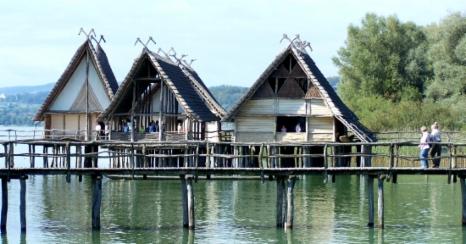
These reconstructed Stone Age/Ice Age Pole Buildings on the banks of the Bodensee (Lake Constance)
(www.pfahlbauten.de) show how the people of the Stone Age built their dwellings on the banks of the Rhine and Main. For more information see: www.archeologie-online.de. Pfahlbauten und Ufersiedlungen.
Clans settled and moved on. But the old settlement on the Rhine, by the mouth of the Main, continued to remain and grew to become an important stronghold for western culture.
Already, before recorded history, the Celtic people established a central settlement here. Then, in pre-Christian times, in the year 38 BC, the Romans established a fort. Mainz (Moguntiacum) became a fortified Roman Legion camp. Regional bastions, like Kastel, were built and the Mouth of the Main (what would become Gustavsburg) were also fortified. With the decline of the Roman Empire, Mainz and the surrounding areas were under constant siege and turmoil, especially by the "Alemans", "Vandals" and even the "Huns" in the year 368 AD. However, the proud structures built in the Middle Ages are still present and stand as witnesses to the never-ending cultural will of our predecessors.
During the 30 Years War, the storms of the Protestant Reformation made their mark on our lands. Brothers fought against Brothers. Even the Swedish King Gustav Adolf became part of the ordeal --and it wasn't only for religious, nor for only direct political reasons, for which he decided to get involved. His troops overran the German lands, and were successful in open battles. Cities were occupied, paralyzed and taken in storm, as was Mainz on 13 December 1631.
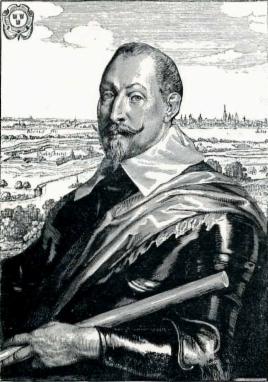
King Gustav Adolf (left above, the Gustavsburg Fortress, right above, the city of Mainz)
A Swedish garrison surrounded the city. Where the Main River emptied into the Rhine River, a massive fortress in the form of a 6-pointed star was built (the Gustavsburg, which literally translates in English to "Gustav's Fortress"). Together with a hoard of men, around 1600 in total, mostly farm-folk from Hesse that were forced to "take building duty", the fortress was errected within one year. Initially and ironically, the fortress was nicknamed "Pfaffenraub" or "Robbed from the Priests", because the Swedes forced new, strict rules of conduct upon the remaining Catholic clergy in Mainz
After the death of Gustav Adolf (which happend during the battle by Luetzen in November 1632), Gustavsburg was granted its "name" through a document drafted by Chancellor Oxenstierna in 1633, as power of attorney for the young Swedish Queen Christina, the daughter of the deceased King Gustav Adolf, who was a mere minor at the time.
In order to establish a permanent settlement with inhabitants within the Gustavsburg fortress, the document promised many privileges. There was enough area within the fortress walls for a church and 600 dwellings. Whomever decided to settle within the fortress, was promised to live there for at least 20 years without the burden of taxes or need to pay tributes.
Chancellor Oxenstirna commanded this message to be posted publically on 04 December 1633. However, not many people were willing to take advantage of the settlement offer (the Gustavsburg fortress remained, more or less, unsettled).
The oldest visual document showing the Gustavsburg fortress is from Merian in the year of its construction, however, only drawn according to the construction plans, with the title "Pfaffenraub" or "Grabbed from the Priests". A later engraving from the same master copper-plate printer Merian, in this instance shown without corner fortifications, is named "Gustavsburg". (see graphic below, Gustavsburg is shown in the lower, left-hand corner)
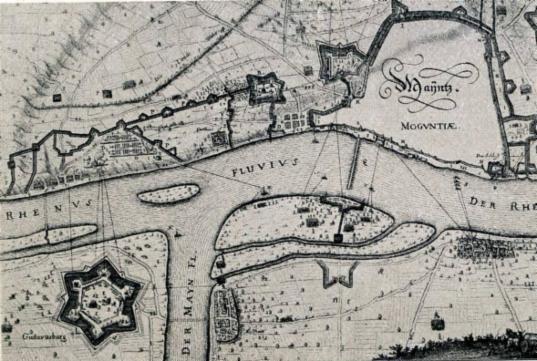
It is safe to assume that the Swedes chose the most efficient and effective form, as they needed to erect the Gustavsburg fortress within a very limited time span.
A Gate Tower secured the one, only entrance to the star-shaped fortress and offered a strategic, wide-panoramic view (to Mainz and Mainz-Kostheim-- the Main River Bridge). The main Gate Tower displayed the coat-of-arms of the Royal Swedish Army and the Ducal Brandenburg Army. Six bastions were errected with stong, stone masonry walls which stood strong on all sides, ready for potential enemies. A thirty meter wide moat with a patrol-walk secured the perimeter of the fortress. The stones and material used to build the Gustavsburg fortress were, more-or-less, taken from the ruin of the "Alban-Stiftes", an ancient cloister, in Mainz. Yes, most of the building materials were "taken" from structures and/or ruins from the left side of the Rhine.
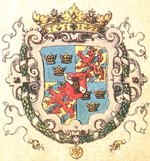
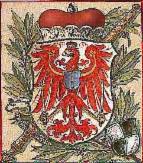
The Royal Swedisch and the Ducal Brandenburg Coat-of-Arms... as on the Gustavsburg Fortress Gate-Tower?
During the construction of the moats of the Gustavsburg fortress, many ancient artifacts were found; many of them dating from Roman times. An altar was found, as well as diverse coins, vases, etc... even statues.
Some of the "larger discoveries" were reused as building material to fortify the walls of the Gustavsburg fortress. The more "notable finds", however, were taken by the French General Courval to the Citadel in Mainz. Some of these "notable finds" can be seen in the museums in Mannheim and Mainz.
Unfortunately, the most spectacular specimens have been lost forever. As can be expected, the most significant , historical artifacts that had been unearthed were to be sent back to Sweden... Cancellor Axel Oxenstierna wanted to send items of historical value back to the Crown of Sweden, including the entire ancient library from the Martins-Fortress in Mainz, a priceless collection from the Eberbach Monestery... The booty was all loaded onto a ship... including the paintings from the Master Matthias Grünewald, "stolen" from the Mainz Cathedral... and all was lost during stormy weather, as the ship with the valuable freight sunk into the depths of the Baltic Sea on its journey back to Sweden.
 Chancellor Axel Oxenstierna
Chancellor Axel Oxenstierna
The historian Josef Fuchs, a Benedictine Monk from Seligenstadt, was convinced that the archaeological finds were proof that a Roman Fort once stood on the site of the Gustavsburg fortress: a square, strongly fortified fort with eight towers --and built by the Roman Emperor Trajan. (With today's knowledge, it is highly unlikely that the Monumentum Trajani refers to the area of Gustavsburg. Some scholars believe the the Monumentum Trajani could refer to a segment of the Odenwald-Neckar-Limes, or another section of the Limes. (Wondering what the "Limes" is? See: http://en.wikipedia.org/wiki/Limes_Germanicus)
Unfortunately, the prospect of organizing successful archaeological excavations, is quite dire --this due to the areal being thoroughly "turned over" during the construction of the Gustavsburg fortress. Even today, when the water level of the Main drops, one can still see the remants of the ancient wooden piles that supported the Roman bridge across the Main, leading to the Roman Legion Fort in Mainz-Kastel (Castellum-Mattiacorum: http://en.wikipedia.org/wiki/Mainz-Kastel).
We can see these only during the rare times that the water level of the Main drops enough for them to pierce the surface of the water. From the layout of these "ancient bridge posts" we can exactly construct the straight, Roman road that was laid, nowdays parallel, to the road along the present MAN factory; the ancient Roman Road, that lead from the Main (River) bridge directly to Gross-Gerau ...and further south to Ladenburg (Lopodunum) on the Neckar River. This Roman road runs in a direct, straight line between Wiesbaden (Aquae Mattiacorum), Mainz-Kastel (Castellum Mattiacorum), today's Kostheim, then incorporating the Roman bridge over the Main River through today's Gustavsburg, directly to Gross-Gerau. The continuing Roman road leaving the Vicus Gross-Gerau breaks the straight line and angles south, continuing further to Ladenburg (Lopodunum), the main Vicus for the next province to the South called Civitas Ulpia Sueborum Nicrensium.
For a visualization of the "Roman Road", see: http://de.wikipedia.org/wiki/Datei:Limes2.png
(Note: in early Roman times, Gross-Gerau was a main Roman legion fort and "Vicus" south & west of the Main and to the Neckar River in the South. This original area, before expanding when the Limes was completed further to the East, was secured by the Odenwald-Neckar-Limes and called Civitas Auderiensium, a province within Germania Superior. As the Civitas Auderiensium area expanded Eastward, Groß-Gerau remained and important Vicus, but the main administrative Vicus became Dieburg, and the Roman troops were stationed within the several Castells along the final, most easterly version of the Limes, the Upper Germanian Limes. Only a fragment of the Roman name for Dieburg is known today, which is Vicus Med..., the Roman name for Groß-Gerau has not yet been confirmed). For further information, see: http://de.wikipedia.org/wiki/Civitas_Auderiensium; http://de.wikipedia.org/wiki/Limes_(Grenzwall)
Source: Wikipedia, see link above
The Gustavsburg fortress, which held steadfast during attacks in 1634, was occupied on 18. September 1635 during a siege upon Mainz by the Emperor's army, but was then taken by the Swedisch army and then retaken by the Emperor. The Gustavsburg fortress proved no longer to be a major factor in terms of security, as the heights on the other side of the Rhine were in the hands of the enemy. During the next few years, the Gustavsburg fortress degenerated into a ruin. The stones of the Gustavsburg fortress were selectively removed and reused within the renovated and expanded fortifications in Mainz, that the Bishop Johann Philipp von Schönborn (1647-1673) was striving to build.
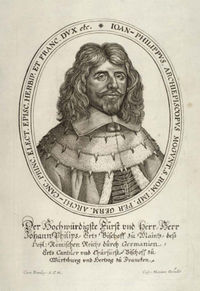 Johann Philipp von Schönborn, Erzbischof zu Mainz
Johann Philipp von Schönborn, Erzbischof zu Mainz
Strangely, and again, in the year 1793, militant armies were present in the Gustavsburg fortress! Mainz was under the control of the French People's Army under General Custine and was under attack by the collective Prussian-Saxonian-Hessian Army. During this occupation, the remaining structures were severely damaged by the Prussian weaponry batteries that were installed on the Main peninsula against Mainz.
The occupation of the city (Mainz) was cause for a major attack of the area surrounding the Gustasvburg. According to historical documents, we can see that the former Gustavsburg fortress was considered a complete ruin and no longer offered significant military value. Thus, the Prussians and Saxons errected their strategic weaponry outside of the fortress (which meant that the fortress itself was not of significant value for their military strategy).
Grass, weeds and shrubbry quickly overgrew the destroyed fortress area, that still can be explored within the terrain of the Oxenwiese (Ochsen Meadow), as it is charted and named after the Chancellor Axel Oxenstierna. Here we can still see the 30 meter wide moat, the remnants of the outer wall, two bastions and the location were the Gate Tower between them once stood.
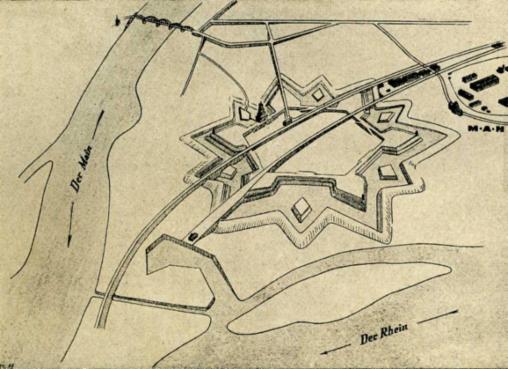
For quite some time, the Rhine and Main sides of the fortress walls served as integral parts of the present Gustavsburg flood-dam system (see above). This was so until the construction of the Gustavsburg Rhine Port Number Four, which made the practical use of the old part of the fortress as part of the dam obsolete. But then, the more "southern part" of the old fortress fortification was integrated into the new dam system, which took over the role of the previous part of the old fortress as "a flood water security dam".
To give you an idea about the locality if the old fortress, the present Train Station, Mainz-Gustavsburg, is almost exactly in the middle point of the former Gustavsburg fortress.
How did Gustavsburg get restarted and settled? In 1859, the Hessische Ludwigsbahn-Society "restarted" Gustavburg! It was really the first train bridge over the Rhine River. The connection between the right- and lefthand side of the Rhine was to be connected by a train bridge... Of course, this was to be designed and built by the company Klett & Co. (MAN) in Nuremberg. To ease the transport of the iron, which came back then from the Saar region, a warehouse was established in Gustavsburg, as well as a construction area and finishing works. Back then, the "Gerber Haus" was built... and because of the perfectly synchronized infrastructure, the MAN factory "Gustavsburg" was built and further developed.
 Logo 1854
Logo 1854
The construction of the Train Bridge over the Rhine River restarted "Gustavsburg" as a town; the MAN factory, train connection and port were the real factors that helped establish Gustavsburg as a place of constant settlement. Hard working people, working on historical lands...
Where the Rhine and Main converge, is a significant piece of German Earth. Magnificent Cathedrals stand on their banks and are witnesses of an ancient culture. Here we were given a Gutenberg and a Goethe...
And today, the melody of history continues to ring, due to the hardship and determination of people from one thousand places...
Das ist Gustavsburg. That is Gustavsburg.